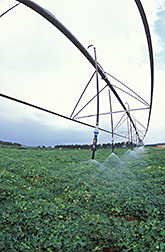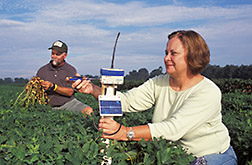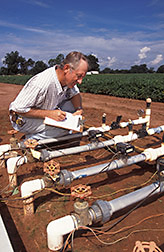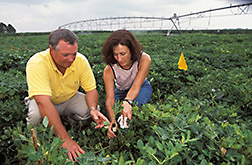Multicrop Rotation and Irrigation Study
for Optimal Water Use in the Southeast
Water is one of the necessities for life and for the livelihood of farmers everywhere. Years of drought and increasing urban usage of water resources are forcing most southeastern U.S. farmers to determine whether irrigation pays and what crops to produce. Alternative irrigation methods, such as subsurface drip and sprinklers, are aimed at achieving this goal.
Growers depend on several factors to stay in business: proper irrigation methods, good crop rotations, and effective marketing to secure the best price for the product.
Researchers at the National Peanut Research Laboratory (NPRL) in Dawson, Georgia, are conducting long-term, multicrop research at a farm location to define the best irrigation management practices for growers of peanuts, corn, and cotton crops. They have completed the 4th year of a 15-year study to determine the impact on profitability of irrigation, crop rotation, and price.
“What growers really need is to have all three components properly in place to stay profitable,” says Marshall Lamb, research leader for NPRL. “If a grower is lacking in any of the three, it can result in a nonprofitable situation.” To help peanut farmers make planting, irrigation, and pest-control decisions, Lamb and his colleagues developed a computer program called Irrigator Pro.
|
|
Irrigator Pro’s goal is to improve economic returns for irrigated peanut production and reduce risk associated with foreign material, immaturity, off-flavor, chemical residues, negative environmental impact, and aflatoxin. More than 20 years worth of scientific research data and information are incorporated in the software to help peanut farmers make informed, appropriate irrigation decisions. The current studies are a way to ensure growers are getting the best recommendations based on data. Results from these studies will be added to Irrigator Pro.
In many regions, irrigation is necessary for crops to grow to marketable size. “Irrigated acreage for crop production in Georgia has increased over the last 30 years. Drought and its impact on crop yield in the Southeast have contributed to that expansion,” says Lamb. “Peanut yields in the Southeast declined 11.5 percent during the 1980s, compared to the 1974-1979 period.”
In 2001, the first year of the current, 15-year study, the drought was quite pronounced, and it deepened in 2002. “That shortage of rainfall led to significant yield declines. Proper management of irrigation resources could increase yield even in drought conditions,” says Lamb.
In the long-term study, corn, cotton, and peanuts are grown in six rotation sequences and with four irrigation methods: over-head sprinkler, subsurface drip, surface drip, and nonirrigation. Water is applied at 100 percent, 66 percent, or 33 percent of the estimated amount the crop needs. The objective is to determine which scheme can achieve the highest yields compared to the amount of water applied—while maximizing profit.
|
|
Success With Peanuts and Cotton
In 2002, a drought year, peanut yields were slightly higher with 100 percent irrigation than with 66 percent irrigation . But the cost of the extra water wiped out the higher-yield benefit. The profit per acre was actually a dollar higher with the lower water amount. But either scheme out-yielded dryland cropping by more than 2,000 pounds per acre (see tables).
Consistent rainfall returned in 2003, resulting in the highest average peanut yields in Georgia’s history, according to Lamb. The per-acre profit was $64 per acre higher with 100 percent irrigation than with 66 percent. Results were from use of sprinkler irrigation.
Cotton in 2002 presented a somewhat different picture. “Cotton prices were low enough—about 50 cents per pound—that 100 percent irrigation returned a small yet positive return, while 66 percent irrigation resulted in only a $2 return to the grower,” says Lamb. But in the wetter 2004, both schemes returned a good profit: $140 per acre for 100 percent irrigation, and $76 for 66 percent (see tables).
For corn in 2002, 100 percent irrigation returned $23 profit per acre, but 66 percent irrigation left a deficit of $5 per acre. It gets much worse with less water: losses of $94 per acre at 33 percent irrigation and $144 with no irrigation.
“Irrigation is costly, so farmers must carefully balance the crop yield response, crop price, and irrigation cost to ensure profitability,” Lamb says. “Farmers invest in irrigation to manage risk in drought years. We must continue this research over many years to make definite conclusions about yield, quality, and economic returns associated with irrigation amounts.”
Rotation Research
In the various rotations, price determines profitability. But a rotation of cotton-cotton-peanut consistently provides higher profit than the other rotations. The second most profitable rotation is cotton-corn-peanut. If the crops are receiving low prices, then the cotton-cotton-peanut rotation is about $57 per acre more profitable than the cotton-corn-peanut rotation. At medium pricing, cotton-cotton-peanut garners $46 per acre more than cotton-corn-peanut. And when high prices can be had, cotton-cotton-peanut realizes about $24 per acre more.
One of the objectives of this research is to improve the growers’ ability to make such investment decisions and to provide them with decision aids like Irrigator Pro to better manage irrigation based on economics and not simply yields.
Which Is Best?
It is clear that irrigation raised yields, quality, and returns in the first few years of the study, but which type of irrigation works best?
The main method of irrigation for peanuts is overhead sprinklers. An alternative method, subsurface drip irrigation, in theory provides greater water-use efficiency than typical overhead sprinklers. Subsurface drip irrigation supposedly maximizes water-use efficiency by reducing soil evaporation, percolation, and runoff by putting water near the roots. Overhead irrigation leaves water on the soil surface, where it can evaporate or run off before it can reach the roots.
Yet, despite the purported benefits of subsurface drip irrigation over sprinkler irrigation, few studies have measured the actual differences in plant water use between the two systems.
Plant physiologist Diane Rowland wanted to find out how efficiently the peanut plant uses water. She investigated the effects of sprinkler and subsurface drip irrigation in peanut plants.
“Using the stem gauges to determine sap flow, we were able to measure the flow of water in the stem at 15-minute intervals for a 24-hour period,” says Rowland. “We found significant difference in peanut water use among nonirrigation, subsurface irrigation, and sprinkler irrigation methods. Plants in the subsurface drip irrigation treatment had significantly higher daily sap flow and used more total water during a 24-hour period than plants in the overhead or nonirrigated treatments. But this increased water use did not translate into more peanuts, just more aboveground foliage.” Overall, Rowland’s research found that subsurface drip irrigation did not necessarily increase the water-use efficiency of the plant.
Next Lamb, Rowland, and the rest of the research team will investigate how conditions such as plant canopy temperature and soil temperature may tell growers when water is needed and how much to apply for most efficient growth and profitability.—By Sharon Durham, Agricultural Research Service Information Staff.
This research is part of Integrated Agricultural Systems (#207) and Water Quality and Management (#201), two ARS National Programs described on the World Wide Web at www.nps.ars.usda.gov.
Marshall Lamb and Diane Rowland are with the USDA-ARS National Peanut Research Laboratory, 1011 Forrester Dr., S.E., Dawson, GA 39842; phone (229) 995-7417 [Lamb], (229) 995-7430 [Rowland], fax (229) 995-7416.
"Multicrop Rotation and Irrigation Study for Optimal Water Use in the Southeast" was published in the November 2005 issue of Agricultural Research magazine.










